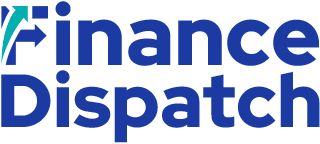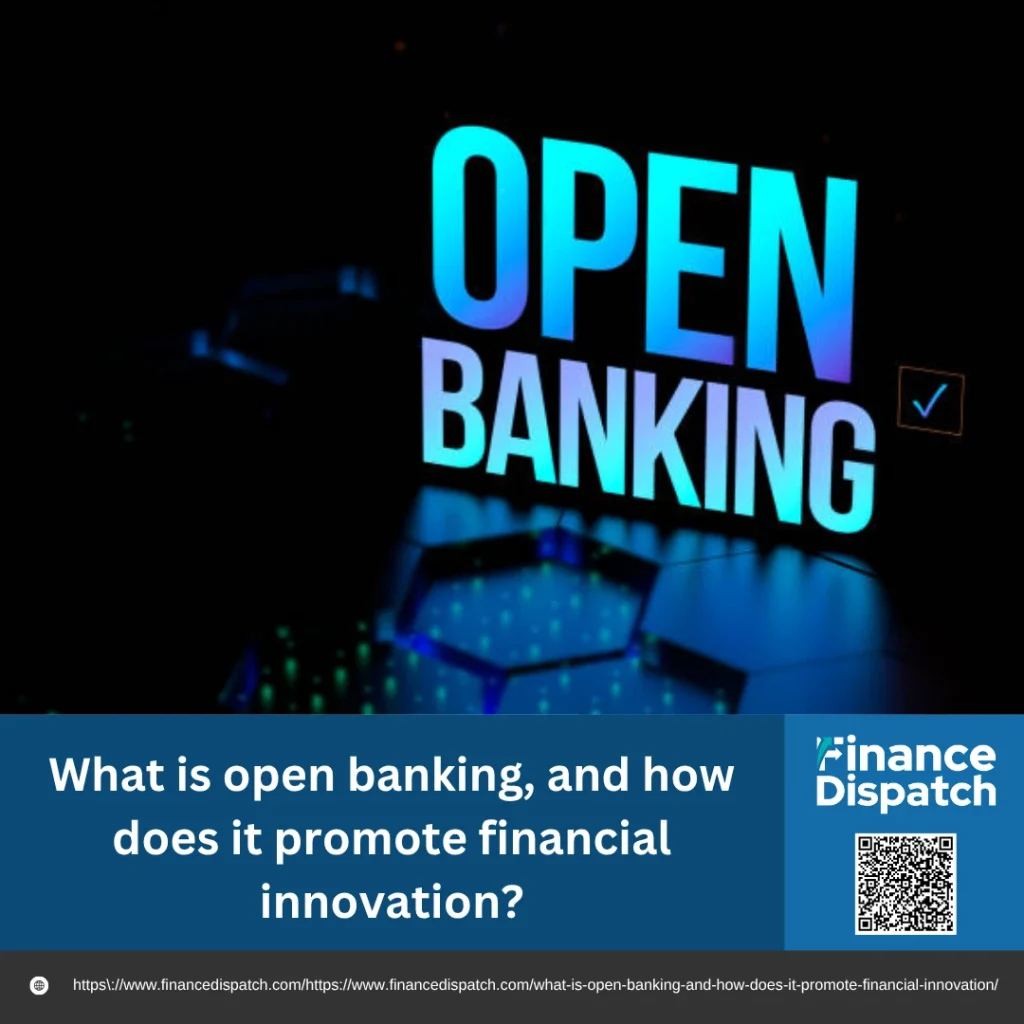In today’s digitally-driven financial world, open banking has emerged as a groundbreaking shift that is transforming the way financial data is accessed, shared, and used. By allowing banks to securely share customer information with authorized third-party providers—only with the user’s consent—open banking is fostering a wave of innovation, competition, and personalization in financial services. Far beyond a mere technical upgrade, it represents a new era where consumers, businesses, and fintechs alike can benefit from smarter, faster, and more tailored financial solutions.
What is Open Banking?
Open banking is a system that allows banks and financial institutions to securely share customer financial data with authorized third-party providers through standardized Application Programming Interfaces (APIs). With the customer’s explicit consent, this data sharing enables greater transparency and unlocks a wide range of personalized financial services—from real-time payment solutions to customized budgeting tools. Governed by strict regulations such as PSD2 in Europe, open banking ensures that security and privacy are maintained while empowering consumers to control how their financial information is used. This seamless data exchange lays the foundation for a more connected, efficient, and innovative financial ecosystem.
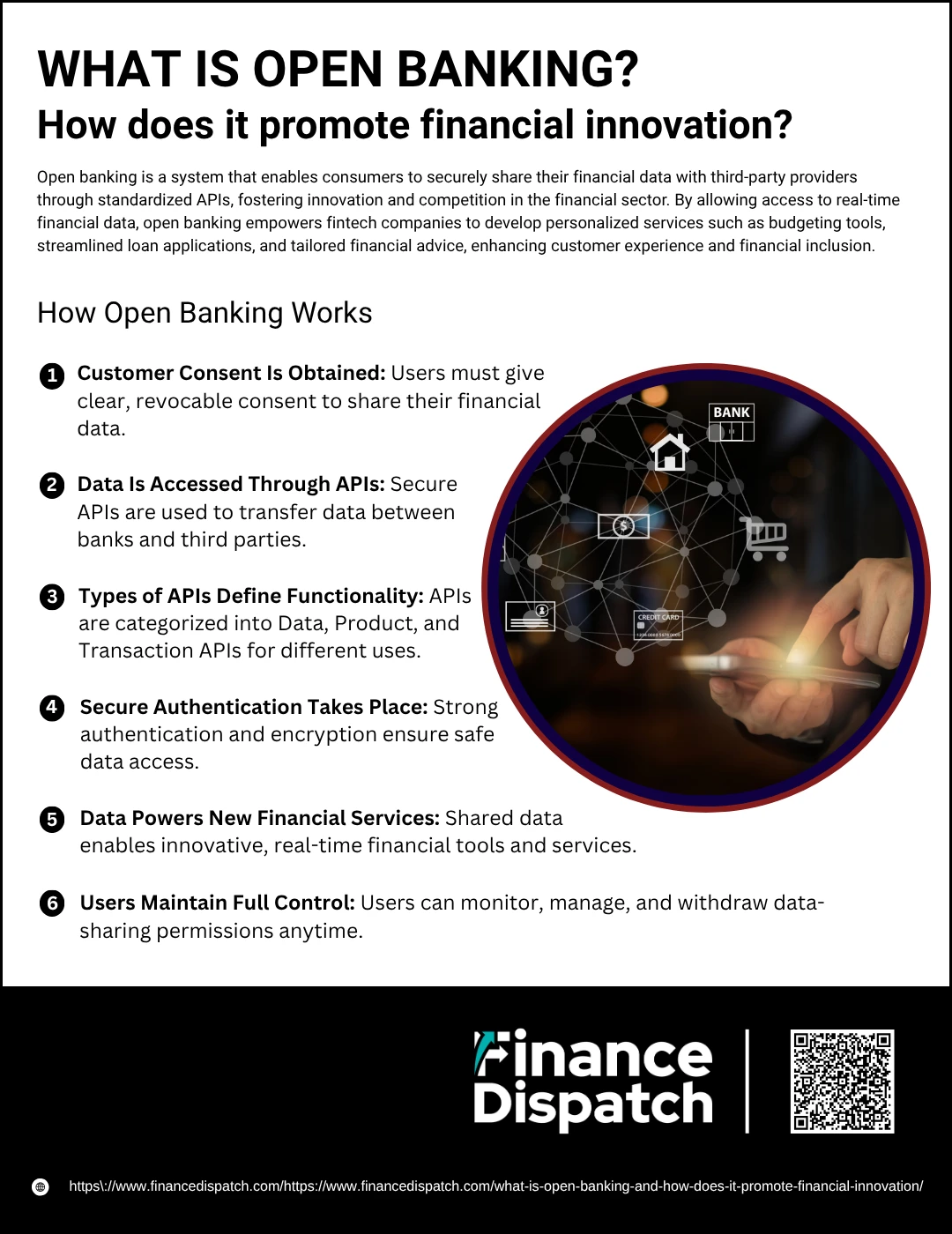 How Open Banking Works
How Open Banking Works
Open banking is built on the principle of secure, transparent data sharing between banks and authorized third-party providers, such as fintech companies or financial apps. Instead of keeping customer data locked within traditional banking systems, open banking uses standardized technologies—specifically APIs—to allow data to flow safely and efficiently between parties. This system empowers customers to use their financial data across different platforms to access tailored products, streamline payments, and manage their finances more effectively. Here’s how the process typically works:
1. Customer Consent Is Obtained
The process starts only when a customer explicitly agrees to share their financial information. Consent must be clear, informed, and revocable, ensuring that users stay in control of what is shared and with whom.
2. Data Is Accessed Through APIs
Once authorized, third-party providers use secure APIs (Application Programming Interfaces) to connect with a customer’s bank. These APIs allow data to be shared electronically without the need for screen scraping or manual input.
3. Types of APIs Define Functionality
Open banking APIs fall into three main categories:
- Data APIs provide access to account balances and transaction history.
- Product APIs allow comparisons of interest rates, fees, and features.
- Transaction APIs enable actions like initiating payments or money transfers directly from a bank account.
4. Secure Authentication Takes Place
To protect user data, banks implement strong customer authentication methods, such as two-factor authentication or biometric verification. Encryption and regulated access protocols are used to prevent unauthorized usage.
5. Data Powers New Financial Services
Once the data is shared, third parties use it to offer innovative services—such as smarter budgeting tools, instant credit decisions, or tailored investment advice—based on real-time financial behavior.
6. Users Maintain Full Control
At all times, users can manage permissions, monitor access, and withdraw consent. This means they remain the ultimate gatekeepers of their own financial information, supported by regulatory protections like PSD2 in Europe.
Types of Data Shared in Open Banking
Open banking enables banks and financial institutions to share specific categories of financial data with authorized third-party providers—always with the customer’s explicit consent. This structured and secure data sharing is designed to improve transparency, enhance service personalization, and foster financial innovation. The data is typically grouped into three primary categories, each playing a key role in powering new digital financial experiences.
1. Account Data
This includes essential details about a customer’s bank account, such as the account holder’s name, type of account (e.g., savings or checking), account number, currency, account opening date, and transaction history including merchants, dates, and amounts.
2. Product Data
Refers to publicly available information about the financial products and services offered by banks—such as interest rates, fees, terms, and conditions. This data is often used by third-party apps to compare offerings across institutions and recommend the best-fit products to customers.
3.Payment Initiation Data
This allows third-party providers to initiate payments on behalf of users, directly from their bank accounts. Instead of logging into bank platforms, users can authorize transfers through apps or websites, improving speed, efficiency, and user experience.
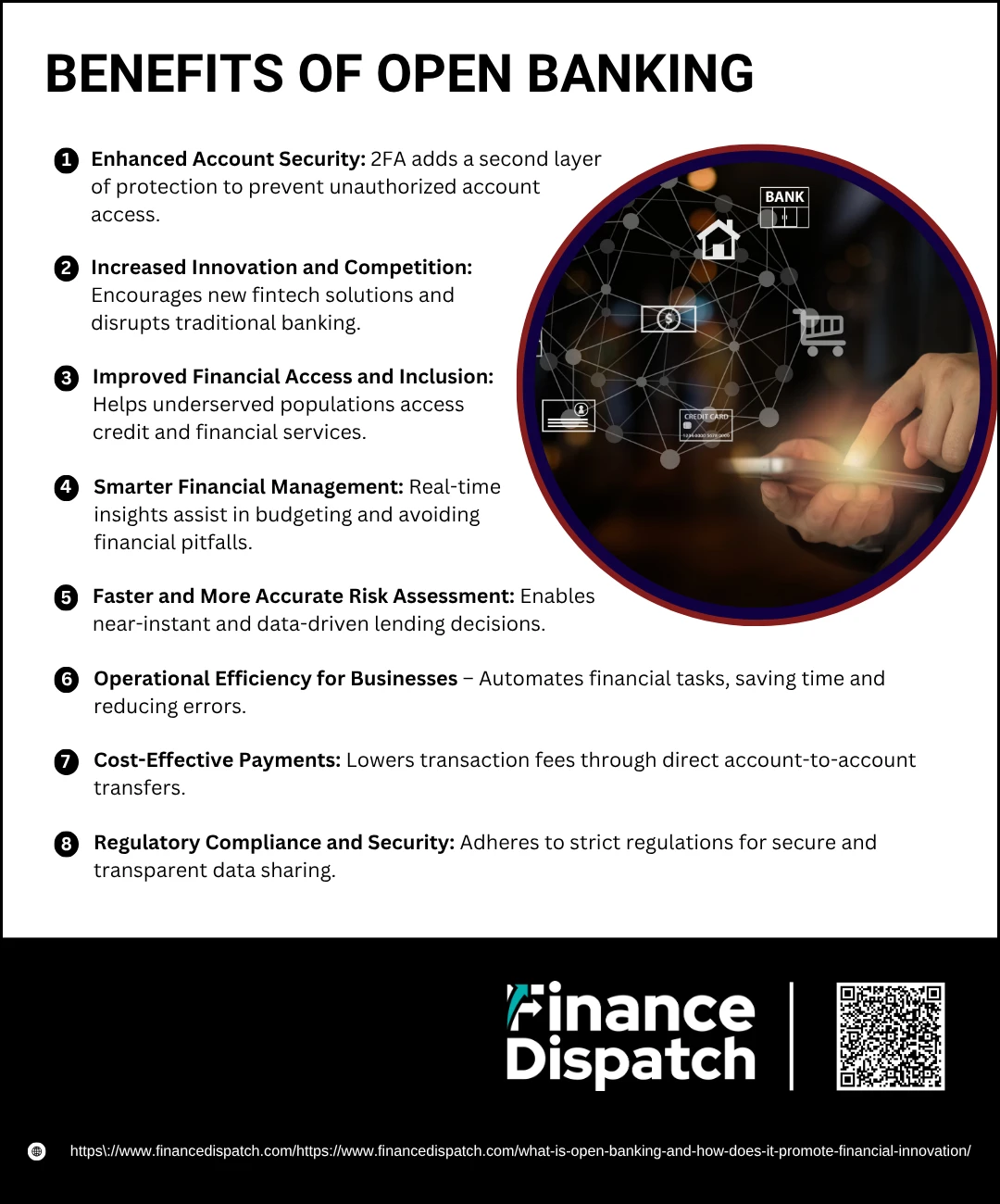 Benefits of Open Banking
Benefits of Open Banking
Open banking is not just a technological advancement—it’s a complete transformation of the financial services ecosystem. By allowing secure and consent-based sharing of financial data through standardized APIs, open banking empowers consumers, encourages competition, and creates new opportunities for innovation. From personalized budgeting tools to faster loan approvals, open banking reshapes how financial services are accessed, delivered, and improved. Below are the key benefits explained in greater detail:
1. Enhanced Customer Experience
Open banking allows customers to manage their finances across multiple banks and apps through a single interface. With a consolidated view of their financial life, users can easily track spending, monitor savings, and receive tailored advice—leading to more informed and confident financial decisions.
2. Increased Innovation and Competition
By opening up access to banking infrastructure, open banking lowers the entry barrier for fintechs and startups. This leads to a surge in innovative services that challenge traditional models and give consumers more choices—whether in payment processing, credit scoring, or investment management.
3. Improved Financial Access and Inclusion
People who lack traditional credit histories—such as young adults or individuals in underserved regions—can still qualify for financial products based on their transaction behaviors and account activity. This improves financial inclusion and ensures more people have access to essential services like loans or insurance.
4. Smarter Financial Management
With access to aggregated data, personal finance apps can analyze income, spending habits, and financial goals in real-time. This allows users to receive budgeting insights, alerts, and financial health scores tailored to their behavior, helping them make proactive choices and avoid debt.
5. Faster and More Accurate Risk Assessment
Lenders can use real-time data to assess creditworthiness, rather than relying solely on outdated credit reports. This allows for near-instant decisions, dynamic credit limits, and improved access to capital for both individuals and small businesses.
6. Operational Efficiency for Businesses
Businesses can automate time-consuming tasks like invoice reconciliation, payment initiation, and expense tracking by integrating open banking APIs. This reduces administrative burden, improves accuracy, and frees up resources for strategic growth.
7. Cost-Effective Payments
Open banking enables direct account-to-account payments, bypassing traditional payment gateways and credit card networks. This means lower transaction fees, faster settlements, and improved cash flow for businesses, especially those operating online.
8. Regulatory Compliance and Security
Open banking is built on strict regulatory frameworks like PSD2 in Europe, which enforce robust security standards, encryption, and strong customer authentication. These safeguards ensure data is only shared with consent and is protected from unauthorized access—boosting trust in digital finance.
Real-World Applications of Open Banking
Open banking is more than a theoretical shift—it’s already driving tangible changes in how people and businesses interact with financial services. By allowing authorized third-party providers to access banking data securely, open banking enables a variety of practical tools and platforms that make money management easier, faster, and more personalized. From payment solutions to investment tracking, here are several real-world applications that demonstrate the value of open banking in action:
1. Payment Initiation Services
Retailers and service providers can initiate direct bank-to-bank payments, reducing reliance on traditional card networks. This results in faster settlements, lower transaction fees, and improved payment security.
2. Account Aggregation
Consumers and businesses can view multiple bank accounts from different institutions in one place, helping them monitor balances, transactions, and savings more effectively.
3. Personal Finance Management (PFM)
Apps use open banking data to offer budgeting tools, spending analysis, and goal tracking, helping users understand and improve their financial habits.
4. Credit Scoring and Instant Loan Approvals
Lenders can access real-time financial data to assess creditworthiness quickly and accurately, streamlining the loan application process and making funding more accessible.
5. Automated Invoice Reconciliation
Businesses can match incoming payments with invoices automatically, reducing manual effort, minimizing errors, and improving cash flow management.
6. Subscription and Expense Tracking
Financial apps can identify recurring charges and subscriptions, helping users manage expenses, cancel unused services, and stay within budget.
7. Multibanking Platforms
Large organizations operating in multiple countries can centralize their financial operations by connecting accounts from various banks into a unified dashboard for better oversight and decision-making.
8. Fraud Detection and Risk Monitoring
By analyzing financial transactions in real time, open banking platforms can detect unusual activity quickly and alert users to potential fraud.
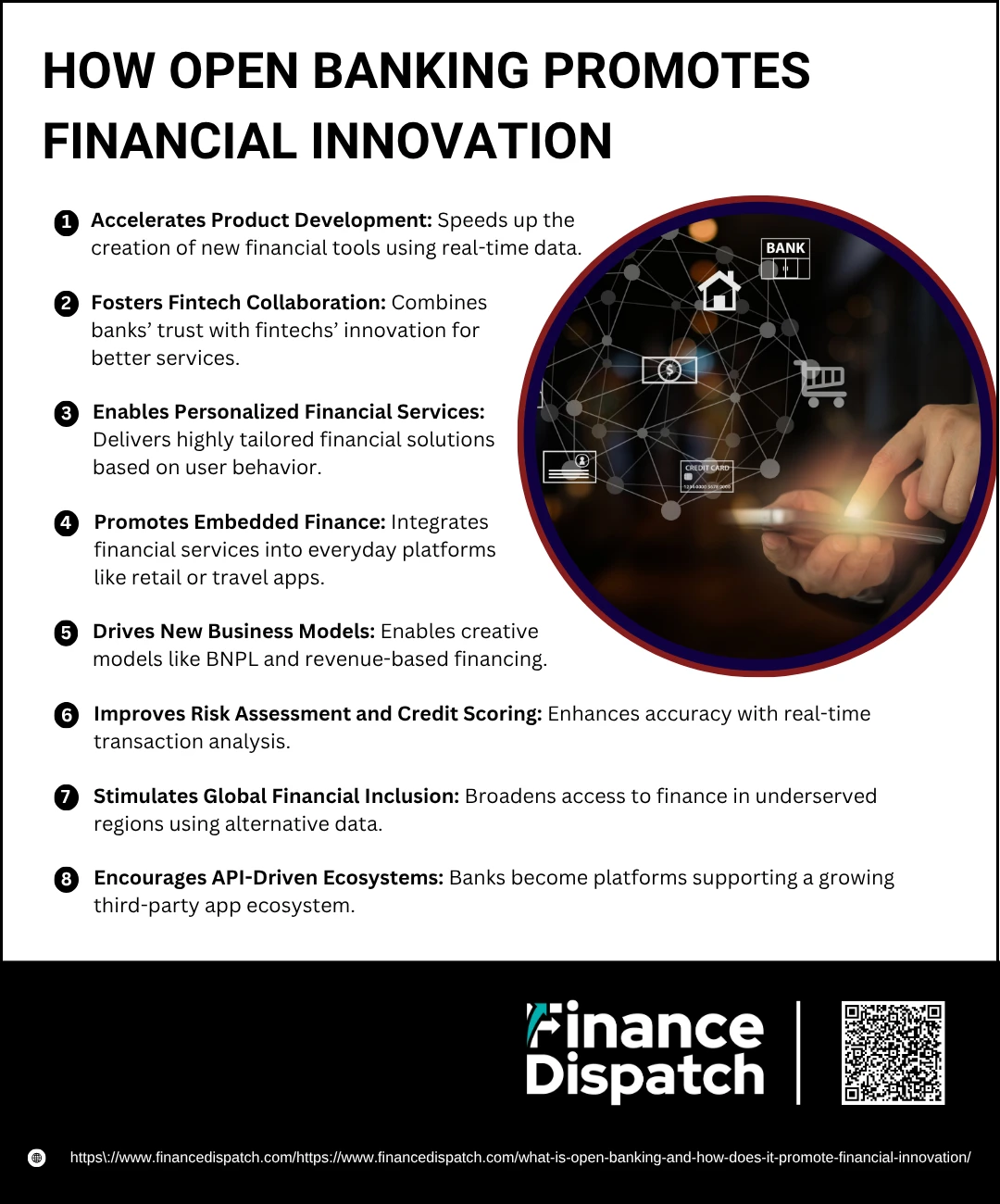 How Open Banking Promotes Financial Innovation
How Open Banking Promotes Financial Innovation
Open banking is a catalyst for financial innovation, fundamentally changing how financial services are developed, accessed, and improved. By securely opening access to financial data through APIs—with full customer consent—it creates a flexible and dynamic environment where traditional banks, fintech startups, and even non-financial businesses can collaborate. This model encourages the design of solutions that are faster, more efficient, and deeply personalized. As a result, financial services are no longer one-size-fits-all—they are tailored, real-time, and driven by data. Here’s how open banking actively fosters innovation across the financial ecosystem:
1. Accelerates Product Development
With access to live financial data via standardized APIs, developers can rapidly test, iterate, and launch new financial tools. This reduces time-to-market and encourages the creation of products that solve real-time user needs, such as on-demand savings apps, spend analyzers, and instant financing platforms.
2. Fosters Fintech Collaboration
Open banking bridges the gap between traditional financial institutions and nimble fintechs. By partnering together, they combine trust and scale with innovation and agility—leading to hybrid services like digital-only accounts, smarter loans, and AI-driven investment platforms.
3. Enables Personalized Financial Services
With granular customer data at their fingertips, providers can deliver hyper-personalized services—from customized investment advice to real-time overdraft protection. This shift from generic offerings to behavior-driven recommendations enhances user engagement and satisfaction.
4. Promotes Embedded Finance
Open banking allows non-financial companies (like retailers or travel platforms) to embed financial services—such as payments, credit, or insurance—directly into their customer experience. This integration streamlines transactions and builds convenience into everyday activities.
5. Drives New Business Models
Innovations like Revenue-Based Financing (RBF), which funds businesses based on expected earnings, are possible because open banking allows real-time revenue tracking. Similarly, Buy Now, Pay Later (BNPL) models rely on rapid access to consumer spending patterns.
6. Improves Risk Assessment and Credit Scoring
Traditional credit scoring is limited and often outdated. Open banking enables lenders to analyze actual bank transaction data, offering more accurate and real-time credit decisions. This not only speeds up approvals but also makes credit more accessible.
7. Stimulates Global Financial Inclusion
In regions with low banking penetration, open banking enables service providers to assess financial behaviors outside traditional credit frameworks—such as mobile payments or utility bills—bringing underserved populations into the formal financial system.
8. Encourages API-Driven Ecosystems
Banks are evolving into platforms that expose their infrastructure to developers via APIs. This API-first approach allows third parties to build specialized apps and services, creating a growing ecosystem of interconnected financial tools.
Impact on the Financial Sector
Open banking is redefining the structure and strategy of the financial sector by shifting it from a closed, institution-centric model to an open, customer-driven ecosystem. This transformation is enabling banks to become more agile, data-focused, and collaborative. Traditional institutions are no longer the sole gatekeepers of financial services; instead, they’re partnering with fintechs, offering APIs, and competing in a landscape where innovation, speed, and personalization are key. Automation and artificial intelligence—powered by access to real-time financial data—are streamlining processes like credit assessment, fraud detection, and financial planning. As a result, services are delivered faster, more accurately, and at lower cost. Open banking also enhances financial inclusion by allowing non-traditional data to inform decisions, expanding access to underserved individuals and businesses. Ultimately, the financial sector is evolving into a more interconnected, transparent, and competitive environment—one that better serves the diverse needs of modern consumers and businesses.
Conclusion
Open banking is more than a regulatory shift—it’s a transformative force reshaping the financial world. By enabling secure, consent-driven access to financial data, it fosters collaboration between banks, fintechs, and developers, unlocking a new era of innovation. Customers benefit from personalized, faster, and more accessible financial services, while institutions gain the agility to adapt to rapidly changing demands. As technologies like AI and automation integrate with open banking systems, the industry moves closer to a truly user-centric, data-powered future. Embracing open banking isn’t just about staying competitive—it’s about leading the way in building a smarter, more inclusive financial ecosystem.
